Gjesdal 发布时间:2021-04-22
一、所属省或是州,具体位置,人口,面积
Gjesdal is a municipality in Rogaland county, Norway. It is located in the traditional district of Jæren. The administrative center of the municipality is the village of Ålgård. Other villages in Gjesdal include Dirdal, Frafjord, Gilja, Gjesdal, and Oltedal. The municipality lies about 25 kilometers (16 mi) to the southwest of the city of Stavanger in southwestern Norway. The 618-square-kilometer (239 sq mi) municipality is the 187th largest by area out of the 356 municipalities in Norway. Gjesdal is the 95th most populous municipality in Norway with a population of 12,002. The municipality's population density is 21.5 inhabitants per square kilometer (56 / sq mi) and its population has increased by 17.6% over the previous 10-year period.
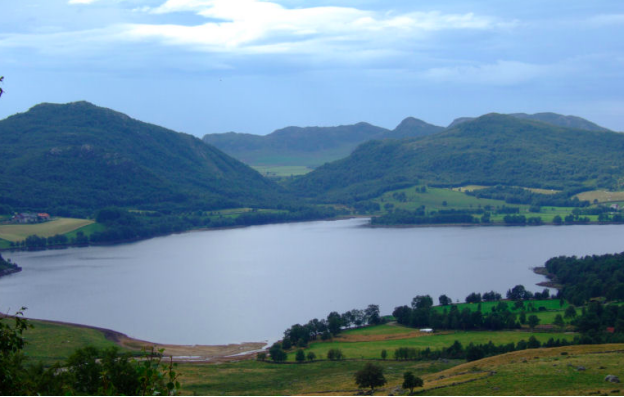
二、自然地理
1.地理条件
Gjesdal municipality is located in the southern part of the Jæren district in Rogaland county. To the north and northwest, Gjesdal borders the municipality of Sandnes, to the east is Sirdal municipality (in Agder county), to the south is Bjerkreim municipality, and to the west is the municipality of Time. Gjesdal sits at the head of the Høgsfjorden and along the south and east sides of the Frafjorden. The Månafossen waterfall, the largest waterfall in Rogaland county, is located in the Frafjord valley. There are several large lakes in the municipality such as Edlandsvatnet, Flassavatnet, Limavatnet, and Oltedalsvatnet. The Figgjoelva river has its headwaters in Gjesdal also.
Gjesdal is considered part of Høg-Jæren. Gjesdal municipality is a mountain and inland settlement located in the transition between Jæren, Dalane and Ryfylke, approx. 30 km southeast of Stavanger.
Area distribution: agriculture: 6%, productive forest: 5%, fresh water: 8%, other area: 81%. The Ålgård community center is located by the E39, 15 km from Sandnes. About. 75% of the inhabitants live here. 35% of the municipality's inhabitants are under the age of 18, which gives the municipality the youngest population in Norway.
The weekly local newspaper for Gjesdal is Gjesdalbuen. "Gjesdalbu" is a term for someone who comes from Gjesdal municipality.
This southeastern part of Ryfylke belongs to the Svekonorvegian bedrock shield, and consists of two main geological formations of Proterozoic rocks formed during the Gothic and later Svekonorvegian mountain range ancestors, with strong metamorphosis under the latter. [5] A substrate of 1,600 - 1,450 million years old slate, quartzite, marble and amphibolite with some hornblende gneiss. The youngest Sveconorvegian formations are witnessed by larger formations of granite. In the municipality, 1,050 million-year-old granitic eye ice dominates the upper structures. The Caledonian mountain range fold did not reach down here. The faults run both in the southwest-northeast direction and in the south-north direction.
Gjesdal is characterized by two types of natural landscape. To the west, Gjesdal is located on the very edge of Jæren with hilly terrain. South and southeast of Ålgård there are several lakes such as Limavatnet and Edlandsvatnet. Both of these have inflows from other smaller lakes and Limavatnet flows into Edlandsvatnet by Vaula bridge. At the southern end of Edlandsvatnet is Langevatn, where the Langevannsverket supplies the northern lake, including Sandnes and Stavanger, with water from water sources in Gjesdal and Bjerkreim municipalities. The river Figgjo flows out of Edlandsvatnet and first flows north before it bends west and out on Jæren.
One should not go far east in the municipality before the Jæren landscape is replaced by mountains and valleys. The valley in Oltedal runs from west to east before bending north and out into Høgsfjord. Oltedalsvatnet is a reservoir for Oltedal power plant and further down Oltesvik power plant. Far south in Oltedalsvatnet, the Madlandselva river flows into the water at Ravndal. East of Oltedal are Dirdal and Gilja which are in a valley that stretches via Byrkjedal and Øvstabø to Hunnedalen. At Byrkjedal is Gloppedalsura, Northern Europe's largest stone clock. The river flows here from Hunnedalen to Høgsfjorden by Dirdal. Just north of this valley is Frafjord which is now connected by a tunnel. At the top of the valley, Måndalen and Brådlandsdalen open out, and Månafossen, Rogaland's highest waterfall, lies by Eikeskog. Like the Dirdalselva and Oltedalselva rivers, the Frafjord river also flows into the Høgsfjord. The Frafjord heaths are protected as a landscape conservation area.
2.交通情况
The European route E39 highway runs through the western side of the municipality. On the east side of the municipality, the Frafjord Tunnel connects the Frafjord valley with the rest of the municipality. The inner arm of the western main road was in 1866 - 1869 led to Ålgård. Before this it was a complicated matter to get to Ålgård from Sandnes. In a call to the state from the municipal council in March 1922, they called for an upgrade of Oltedalsveien between Vaula bridge and Oltesvik, referred to as "this miserable road". The road eventually got the highest priority and the municipality advanced money to start the work. This work continued until the 1930s.
Two major roads today run through Gjesdal municipality. Europavei 39 runs from north to south, while county road 45 runs from west to east. Europaveien connects Ålgård to Sandnes and Stavanger in the north, while to the south it goes towards Kristiansand. The national road starts at E39 at Vaula bridge just south of Ålgård and goes via Lima, Lomeland, Oltedal, Dirdal, Gilja, Byrkjedal, Øvstebø and leaves Gjesdal in Hunnedalen. county road 506 runs from E39 to Bryne.
The bus connections between Sandnes and Ålgård are good with mostly departures every half hour from Columbus, while the bus inland towards Oltedal and Gilja requires more planning. Bjerkreim Bus also runs via Ålgård towards Vikeså, and Ålgård is also a stop for express buses on the way from Stavanger south to Egersund and Kristiansand and east to Oslo. Ålgård has no bus station. Ålgård previously had a railway connection to Ganddal and Sandnes. The Ålgård line has not been closed, but operations have been suspended. The track is partly used for heavy traffic in the northern part, otherwise for trolleys and museum trains. The association Ålgårdbanen's friends will have operations on the track.
三、经济发展和规模
Today, only Gjestal Spinneri in Oltedal is left of the woolen goods industry around which the towns of Ålgård and Oltedal have grown up. At Gilja is Gilje Tre, which produces windows and exterior doors. Jæder lives in Ålgård and Styro has operated in Oltedal since 1983.
The geography of the area makes water an important raw material alongside wool. Langevannsverket supplies drinking water, while Oltedal power plant, Oltesvik power plant and Maudal power plant supply electricity. In addition, turbines have been built into the Langevannsverket and DFU's facilities.
The wool industry and the power industry, together with agriculture, were for many years the main industries in Gjesdal, and there was a shortage of space for new industry. After the area along the Figgjoelva by Kongeparken had been filled up, Gjesdal was without opportunities to offer commercial plots for a long time. This peaked when Goman was to establish a bakery in the area. From Goman's side, it was very desirable to move the plant to Gjesdal, but after time passed and nothing settled, the plant ended up in Sandnes municipality. The building is located on the border in Sandnes. The case triggered discussions about the future of the business community in Gjesdal, and the municipality decided in 2002 to build a new industrial area on Skurve about three kilometers south of Ålgård. The plans were expanded after Asko Rogaland had bought a 30,000 m plot, and the facility now comprises (2017) approx. 600 goals.
Motorists driving on the E-39 along the industrial area questioned the safety of the embankment that was built up along the road. On October 30, 2006, the municipality published Stavanger Aftenblad and assured that the area was safe. The next day, a landslide 20 meters wide blocked the road. The road was then closed until November 24. Gjesdal has some of the most visited tourist destinations in Rogaland in Kongeparken, Byrkjedalstunet and Månafossen. In addition, the outdoor area Brekko is located here. Brekko (pronounced with å) is especially used a lot in the winter as there is a light trail, heating room, open-air chapel and from the winter of 2006 snow cannon here. In addition, the facility has a stand for biathlon.
https://www.gjesdal.kommune.no/tjenester/politikk-og-administrasjon/okonomi/budsjett-okonomiplaner-og-arsmelding/
https://www.gjesdal.kommune.no/_f/p21/i13d95177-07a1-4bdc-9f6a-3a0485ba77c1/budsjett-og-okonomiplan-2019-2022-kommunestyrets-vedtak.pdf
四、产业特点重点项目
Gjesdal municipality is a good municipality to grow up in for most people. At the same time, we have demanding challenges that we must tackle, and not just talk about. Gjesdal KrF therefore proposes a battery of concrete measures to do something about some of the major challenges. We want growth. We want children. We want good conditions for growing up. For happy children often provide harmonious inhabitants who thrive and who contribute back to society.
Free kindergarten for children number 3 and beyond.
Birth rates are set to plummet in the municipality. We see it at Ålgård and we see it at Dirdal that the percentage of births has suffered a severe setback. It is expensive to have more children, and this can be a factor that comes into play when considering whether to have more children. Gjesdal KrF therefore wants to provide free kindergarten to those who have children number three or more. It will be a clear signal that Gjesdal municipality will support the families who choose to have more children.
More children gives more inhabitants. More inhabitants provide higher tax revenues and subsidies from the state. And good schemes for families with children in Gjesdal will be able to make it even more attractive to settle in our beautiful municipality. Because if we focus on kindergartens, then we focus on families with children.
Free cultural school
The difference in living conditions is increasing in Norway. We are increasingly challenged by the fact that some children do not participate in the development of prosperity because they live in low-income families. This has several unfortunate sides, and unfortunately the challenges often accumulate when you are left at a lower welfare level. Among other things, it turns out to be challenging for some of the children in low-income families to participate in leisure activities. Among other things due to contingent, deductibles, voluntary work or sale of doruller. A compensatory measure can be to provide free offers in the cultural school in Gjesdal to these children, so that nothing financial is required of the parents.
Two new health nurse positions
We must prioritize early intervention to identify health and social challenges early. This can be done through a stronger presence of nurses in kindergartens and schools in the municipality. We want to strengthen the budget with two new health nurse positions, through a health nurse being able to work permanently in the kindergartens at Dirdal / Oltedal / Ålgård. Besides that a nurse works permanently in the schools. This is an effective way to meet and see the children, and at the same time identify challenges at an early stage. We are far behind the norm numbers in Norway.
Overcapacity in kindergartens
In the foreseeable future, we will have overcapacity in kindergarten places in the municipality. At the same time, as is well known, we have undercapacity in other important focus areas. It is difficult to live with such an imbalance. We will therefore support the councillor's proposal from 2017 to close one of the kindergartens. This provides funds for
Gjesdal municipality, Rettedalen 1, 4330 Ålgård. Phone 51 61 42 00. e-mail: post@gjesdal.kommune.no. www.gjesdal.kommune.no 10
a health nurse position that benefits all children in kindergartens. We believe this is an important move for the local community, although it can be sad for some children to have to change daycare in the middle of the race.
Cuts in municipal sponsorship of the Blink festival
The Blink festival is a great initiative and a folk festival in Gjesdal. At the same time, we see ourselves having to address the major challenges first, and thus we must downgrade municipal support for the Blink festival. We believe this is a task for the business community in Gjesdal when we are in such a stressful financial situation for the municipality.
Strengthening of open kindergarten
Open kindergarten worked very well in a municipal context, and had many satisfied users. Now this offer has passed on to volunteers through the Baptist Church taking over the responsibility. We want to expand this offer, which is important for a good number of families with children - often in a transitional phase. It may be because you are between jobs. This may be because it is a priority to be at home with the child for an extra year. Or it may be because you are new to the municipality and want to build networks with your children. We applaud the volunteers who do a good job at a cheap price for the municipality.
Pre-engineering of new plots on Gilja
We want growth in the inner parts of Gjesdal municipality. Gilja is starting to run out of attractive plots. We will therefore make concrete progress in the development of more residential plots on the slope up to Giljastølen to get the best possible sun conditions for the residents. Money is set aside here to take concrete steps to be able to get more inhabitants to the inner parts of the municipality.
Fresh funds for teams and associations for children and young people
Gjesdal KrF wants to contribute with fresh funds that go directly to teams and associations run by volunteers - for children and young people in the municipality. Sports teams, 4H, churches and others contribute to creating good conditions for growing up in a way that we are completely dependent on. We will cheer even harder on this work.
https://www.gjesdal.kommune.no/tjenester/politikk-og-administrasjon/okonomi/budsjett-okonomiplaner-og-arsmelding/
https://www.gjesdal.kommune.no/_f/p21/i13d95177-07a1-4bdc-9f6a-3a0485ba77c1/budsjett-og-okonomiplan-2019-2022-kommunestyrets-vedtak.pdf
五、风景名胜,景点( attractions)
1. Gjesdal Church
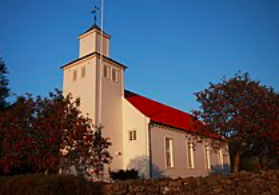
Gjesdal Church (Norwegian: Gjesdal kirke) is a parish church of the Church of Norway in Gjesdal Municipality in Rogaland county, Norway. It is located in the village of Gjesdal. It is one of the three churches for the Gjesdal parish which is part of the Jæren prosti (deanery) in the Diocese of Stavanger. The white, wooden church was built in a long church style in 1848 using designs by the architect Hans Linstow. The church seats about 450 people.
The earliest existing historical records of the church date back to the year 1395, but the church was probably built during the 13th century. The old stave church existed for many centuries. In 1745, the church was renovated and a new nave was constructed, but the old choir was not changed. In 1802, the nave was rebuilt again. It was extended and widened and the roof was raised higher as well. In the spring of 1848, the church was torn down and its materials were sold at an auction. During the next several months, a new church was rebuilt on the same site. The new church was consecrated in October of 1848.
2.BIRD WATCHING
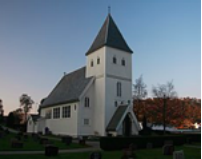
Old Ålgård Church (Norwegian: Ålgård gamle kirke) is a historic parish church of the Church of Norway in Gjesdal Municipality in Rogaland county, Norway. It is located in the village of Ålgård. It used to be the main church for the Ålgård parish which is part of the Jæren prosti (deanery) in the Diocese of Stavanger. The white, wooden church was built in a long church design and an art nouveau style in 1917 using designs by the architect Ole Stein. The church seats about 250 people.
Work began on the new church on March 20, 1916 when a groundbreaking ceremony was held. The church was consecrated on 11 May 1917 by the Bishop Bernt Støylen. The church cost about 29,000 kr to build. There are several bullet holes in the exterior of the church that were caused by skirmishes during World War II when the Germans occupied Norway. In the 1960s, the church was renovated and refurbished. After 98 years in use, the church became too small for the congregation and it was replaced in 2015 by the new Ålgård Church, located directly across the street. The old church is no longer used for regular services, but it is used for special occasions such as weddings.
3. Månafossen
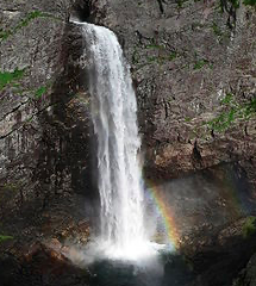
Månafossen is a waterfall in Gjesdal municipality in Rogaland county, Norway. The 92-meter (302 ft) tall waterfall is located along the river Månaåna, about 6 kilometers (3.7 mi) east of the end of the Frafjorden where the village of Frafjord is located. The waterfall is in a fairly isolated area. There is a parking area nearby with a steep, rough 250-meter (820 ft) hiking trail up a mountainside to see the waterfall. The hike takes about 30 minutes.
六、历史文化
1.历史
The municipality (originally the parish) is named after the old Gjesdal farm (Old Norse: Gesdalir), since the first Gjesdal Church was built there. The first element is probably an old river name and the last element is the plural form of dalr which means "valley" or "dale".
Before 1889, the name was written Gjæsdal, which is the Danish spelling. During the period from 1889-1917 it was spelled Gjesdal (Norwegian language version). Then starting in 1918, it was spelled Gjestal after the pronunciation of the local dialect (the d in dal is pronounced t because of the voiceless consonant s in front). In 1964, the spelling was changed back to the etymologically correct form of Gjesdal.
The coat of arms was granted on 15 March 1985. The arms show a white sheep's head on a blue background. The sheet was chosen as a symbol because sheep breeding and wool manufacturing have both been important throughout the history of Gjesdal. The wool industry was centered in the village of Ålgård where wool, textile, and clothing businesses have thrived.
The parish of Gjæsdal was established as a municipality in 1838 (see formannskapsdistrikt law). It was originally much smaller than it is today, centered on the Gjesdalen valley in the western part of the present-day municipality. During the 1960s, there were many municipal mergers across Norway due to the work of the Schei Committee. On 1 January 1965 several areas were merged to form a much larger municipality of Gjesdal:
the original municipality of Gjesdal (population: 3,353)
the Nedre Maudal area in Bjerkreim municipality (population: 40)
the Oltesvik area along the Høgsfjorden in Høle municipality (population: 37)
the parts of Forsand municipality south and east of the Frafjorden including Dirdal, Frafjord, Byrkjedal, Øvre Maudal, and Østabødal (population: 621)
On 1 January 1970, an unpopulated area of Time Municipality was transferred to Gjesdal. Then on 1 January 1989, another small, unpopulated area of Time was transferred to Gjesdal.
Gjestal skipreide was established in 1634. Before this the area belonged to Gand skipreide. Usually each shipowner had his own sheriff, but in a period from 1787 to 1851 Gjestal had a sheriff together with Gand, consequently Sandved was the courthouse for Gjestal for a time. The most local part of the judicial system was the conciliation commission that Gjestal shared with Time until 1842. People in Gjestal therefore had to go to Lye to have their cases processed.
Gjestal presidency district was established in 1837. The attendance at the autumn and tax council for Gjestal at Sanved on 21 November 1837 was large when the first municipal election was to be held. It was not a matter of course that Gjesdal should have its own chairmanship since it was a parish under Lye parish, but this was decided unanimously by election at this thing in Sandved. The first chairmanship meeting was held on the farm Nese on the other side of Edlandsvatnet from Ålgård. The presidency had three members and at this meeting had only one task: To elect a mayor and deputy mayor. Jesper Tjølson Ravndal, who was one of two electors from Gjestal who was to elect envoys to Eidsvoll in 1814, became mayor and Lars Svendson Oftedal became deputy mayor, both with two votes.
Municipal elections were then held every other year, and half of the municipal council was to be replaced each time. In the second election, therefore, a lottery was held to decide who should leave the board. In 1851, the courthouse was moved to Mossige and Norheim in Time after the courthouse was introduced and since Gjestal belonged to Time courier. "The long road to the courthouse in Time" led to low turnout.
The road from Sandnes to Ålgård was improved in 1866 - 69, and this laid an important foundation for industry at Ålgård. Ole Nielsen looked for a place where he could move his spinning mill, and the improved road together with the power source that the waterfall at Ålgård could be and the supply of wool, made him move production in 1870 and founded Aalgaard's Wool Spinning Mill which was the basis for the United Wool Factories. An industrial adventure followed and Ålgård grew rapidly. Some of the same thing happened in Oltedal, and there the development accelerated when the Oltedal power plant was put into operation in 1909 and eventually the Oltesvik power plant. Several spinning mills were started, but eventually it was Svanedal Ullvarefabrikk that became dominant in Oltedal until Gjestal Spinneri was established in the 1930s. The roads between Ålgård and Oltedal before the 1920s were miserable, but Oltedal had a shipping port in Oltesvik.
The war in Rogaland south of Boknafjorden took place mainly in Gjestal. In Weserübung there were two attack targets in Rogaland, Stavanger and Egersund. But it was the military planning on the Norwegian side that was to add the war to Gjestal. On April 9, 1940, Colonel Spørck quickly realized that the Stavanger Peninsula was a trap. The mobilization of the Rogaland Battalion was quickly moved from Sviland to Dirdal and Gilja, while the Hunter Battalion moved to Oltedal on the same day. Colonel Spørck started the transfer of the forces to Setesdal when the road via Helleland was blocked by advancing Germans from Egersund. Major Brandt took part of the force with him, against the colonel's orders, and advanced to Ålgård, Figgjo and Bråstein.
In the meantime, Colonel Spørck had been informed that the forces in Setesdal had capitulated. Therefore, he returned, and was in Dirdal on April 17, the same day as the "battle of Ålgård" took place. The Germans advanced on both sides of the river and advanced to Risfjellet at 14.00, and from there they got a good grip on the Norwegian positions. Two hours later, the Germans had taken Ålgård. A Norwegian soldier lost his life at Figgjo.
2. 文化体育
Finn Erling Kydland (born 1 December 1943) is a Norwegian economist known for his contributions to business cycle theory. He is the Henley Professor of Economics at the University of California, Santa Barbara. He also holds the Richard P. Simmons Distinguished Professorship at the Tepper School of Business of Carnegie Mellon University, where he earned his Ph.D., and a part-time position at the Norwegian School of Economics (NHH). Kydland was a co-recipient of the 2004 Nobel Memorial Prize in Economics, with Edward C. Prescott, "for their contributions to dynamic macroeconomics: the time consistency of economic policy and the driving forces behind business cycles."
Dagny Mellgren (born 19 June 1978) from Ålgård is a former Norwegian footballer. She retired in December 2005 while playing for Klepp. She has also played for Boston Breakers, in the WUSA. She scored the golden goal which gave Norway the Olympic gold medal in Sydney 2000.
Gjesdal has four football clubs. Ålgård FK is one of the largest football clubs in Rogaland in terms of number of members. The team plays in the 2nd division, and has Ålgård 2 in the 4th division. Oltedal FK plays in the 5th division, while Dirdal IL plays in the 6th division.
Gjesdal IL has groups in athletics, volleyball, cross-country skiing and triathlon. Most famous is the sports team for its participations in the Holmenkoll relay where the relay team was number three and best Norwegian team in the elite class in 2002 and 2003.
七、其他信息
All municipalities in Norway, including Gjesdal, are responsible for primary education (through 10th grade), outpatient health services, senior citizen services, unemployment and other social services, zoning, economic development, and municipal roads. The municipality is governed by a municipal council of elected representatives, which in turn elect a mayor. The municipality falls under the Jæren District Court and the Gulating Court of Appeal. The municipal council (Kommunestyre) of Gjesdal is made up of 27 representatives that are elected to four year terms.
八、联系方式
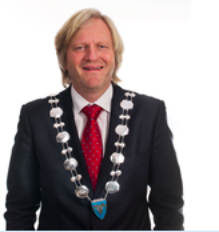
Town manager: Frode Fjeldsbø
Phone:980 18 908
Email:ordforer@gjesdal.kommune.no
Address:Gjesdal municipality Rettedalen 1 4330 ÅLGÅRD
https://www.gjesdal.kommune.no/tjenester/politikk-og-administrasjon/politikk/ordforer/ordforer-i-gjesdal/
